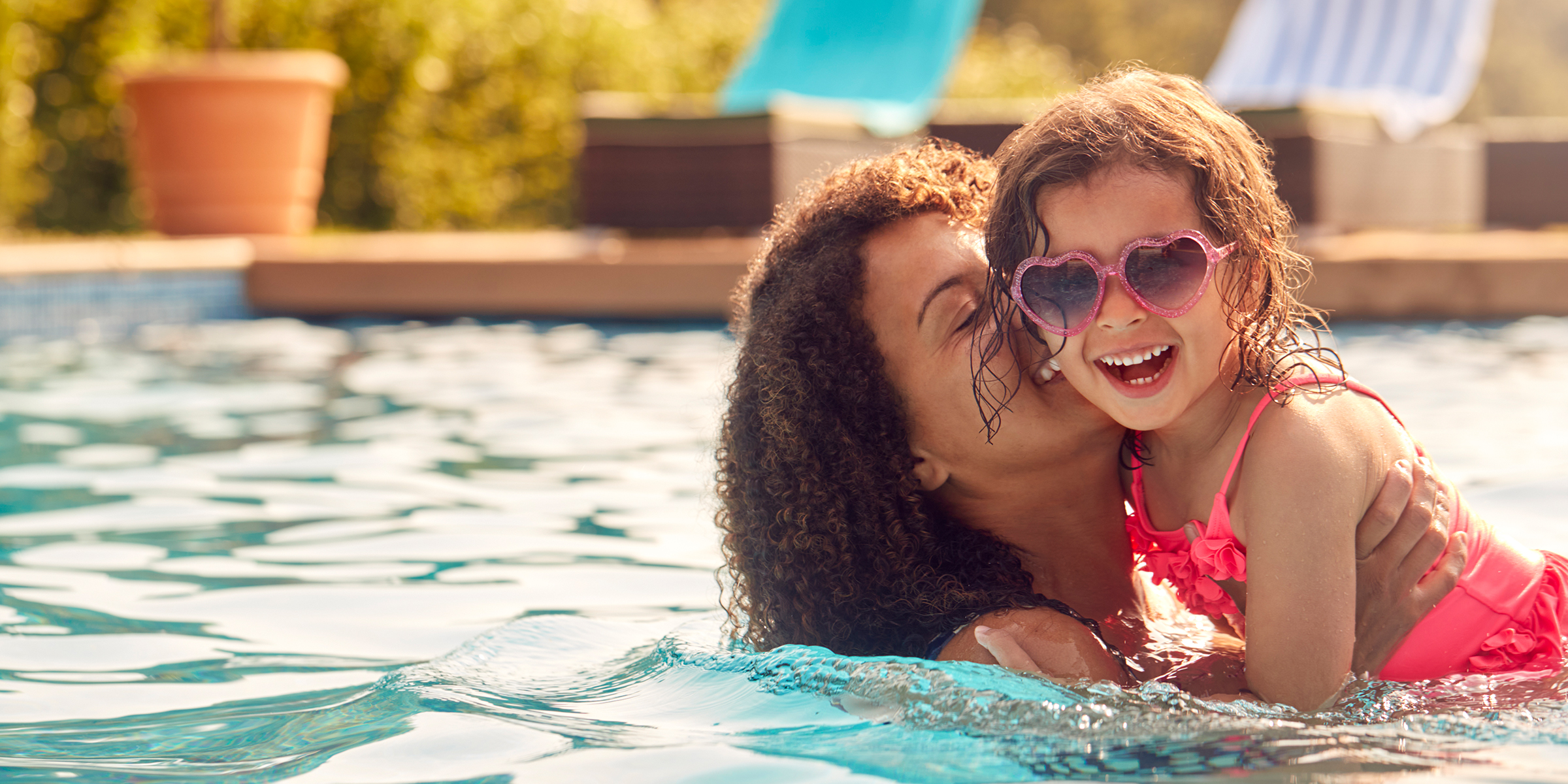After investing time, effort, and money into achieving your dream of owning a pool, seeing your pool filled with crystal-clear water is an exciting moment.
The next step of adding chemicals for the first time can be intimidating for new pool owners- but it doesn’t need to be!
Read on for helpful tips on how to put chemicals in a pool for the first time to ensure your pool is safe and properly balanced for swimming.

What Should I Do When Chemically Treating My Pool for the First Time?
If you’re unsure how to put chemicals in a pool for the first time, follow these steps.
Step 1: Fill your swimming pool! Once full to the recommended capacity, turn on the pool pump to circulate the water through the filter. Use AquaChek Test Strips to determine chlorine, pH, and total alkalinity levels. Now you know what needs to be treated.
Step 2: Add pool chemicals one at a time, with 30 minutes between each addition. Distribute the chemicals using a pool brush and make sure your pool pump is running to help circulate them.
Now what? What chemicals do you put in a pool for the first time, and in what order?
- Alkalinity increaser. Adjust your pool’s alkalinity to between 80-100 ppm (parts per million) using Hy-Clor Alkalinity Increaser. If the alkalinity is maintained, pH fluctuations will reduce, and chlorine efficiency will increase.
- Balancer chemicals. Balance your pool’s pH levels to between 7.2-7.6. If the readings are off, use Hy-Clor pH Decreaser (dry acid) to lower the pH or Hy-Clor pH Increaser (soda ash) to raise it.
- Calcium increaser. Raise the calcium hardness using Hy-Clor Calcium Increaser. We recommend a level of 200-400 ppm so that the water balance is easier to maintain.
- Stabiliser (cyanuric acid). Add stabiliser to protect chlorine against the sun’s powerful UV rays. Maintaining a stabiliser level of 30-50 ppm can extend chlorine’s life by up to 50% in summer.
- Chlorine. Add chlorine in liquid, granular, or tablet form to kill bacteria and keep your pool water clean. Levels should be between 1-3 ppm.
- Salt. IF your pool has a salt chlorinator check with the manufacturer for recommended levels and add the correct amount. Remember to brush the salt once it has been added to avoid staining the surface. Check with your pool builder if you should add salt straight away or wait a period of time.
Step 3: After 48 hours, retest the water to check it’s balanced, and if not, repeat the process until it is.
It may take some time to understand what your pool needs, but if you follow these steps, you’ll get the hang of the process in no time!
Does It Matter What Order I Add Chemicals to My Pool?
Yes, to get the best results, it’s vital to understand which chemicals mix and how to introduce them into your pool for optimal performance.
Adding chemicals in the wrong order can result in an incorrect combination of chemicals, leading to volatile reactions. Such reactions can cause skin and eye irritation.
Imbalances in your pool’s water chemistry can also occur, making it difficult to reach a chemical balance and causing chemicals to become ineffective.
Follow the steps listed above in this article to get the order right!

Does It Matter What Order I Add Chemicals to My Pool?
It’s best to wait until chlorine levels reach three ppm before swimming in a pool after adding chemicals. Safe practice is always to test first! Or a good rule of thumb is to wait 24 hours before taking a dip.
It’s critically important to never mix chlorine with muriatic acid or dry acid inside or outside your pool. This mixture can create a dangerous toxic gas that’s harmful if inhaled.
If you need to adjust the pH level of your pool and add acid, be sure to do so separately and wait several hours before adding chlorine.
Also, never shock your pool immediately after adding acid to it.
Always follow the manufacturer’s instructions for dosing and adding chemicals to your pool, and wear protective gear such as gloves and goggles.
Shock and chlorine are different – shock has a more intense chemical composition than regular liquid chlorine sanitisers.
Liquid chlorine is used to sanitise pool water, while shock is a treatment that rapidly raises the chlorine level in your pool water to destroy bacteria and other contaminants.
Chlorine and shock also differ in application. Typically you add liquid chlorine regularly to maintain a consistent chlorine level in your pool water. On the other hand, you would use shock treatments in higher doses than regular chlorine to address specific problems, such as cloudy water or the buildup of contaminants.
Never mix pool chemicals, and never add all of them at once. Doing so can lead to dangerous chemical reactions and serious injuries. Also, it will make it impossible to balance your pool water.
Before deciding whether to shock your pool after filling it, consider your water source. If there are no known issues with the water source, you can generally trust that there won’t be any harmful bacteria present.
If you suspect your pool was filled from a questionable water supply, it may be best to shock your new pool as a precaution. Test the water’s pH and chlorine levels before adding any shock to ensure it dissolves completely and doesn’t react with other chemicals in your pool.
Talk to a Pool Professional About Adding Chemicals to Your Pool for the First Time
If you’re still trying to figure out where to start when adding chemicals to your pool for the first time, reach out to the professionals at Hy-Clor for help. Our knowledgeable team is here to provide you with the best advice on which high-quality Hy-Clor chemicals to use.
For more information on how to put chemicals in a pool for the first time, enquire via our online form. Alternatively, please visit your nearest Bunnings Warehouse for our full range of products.




